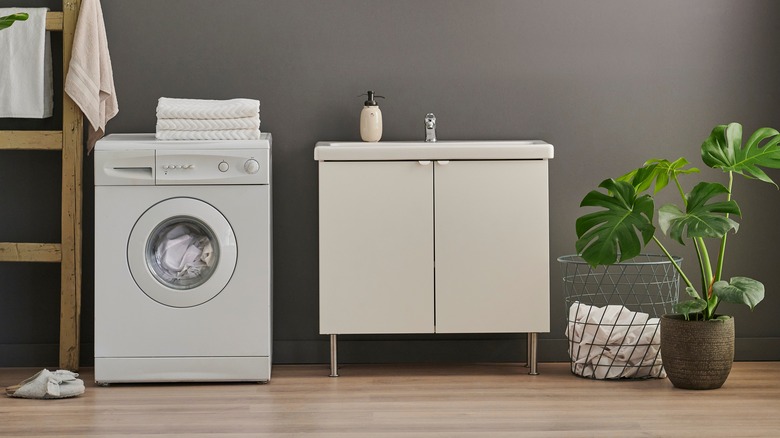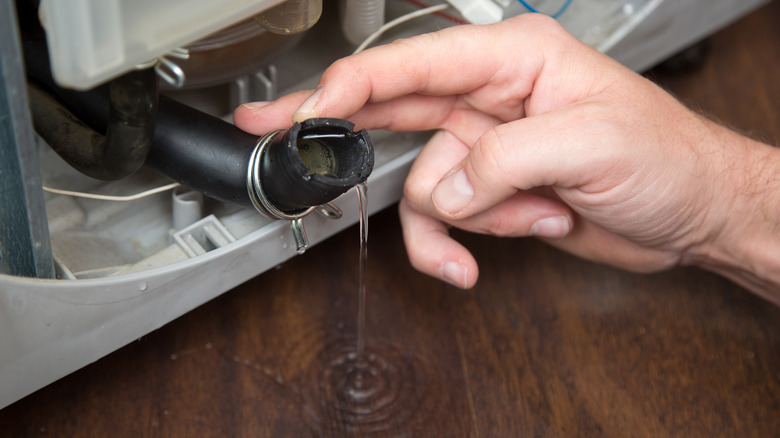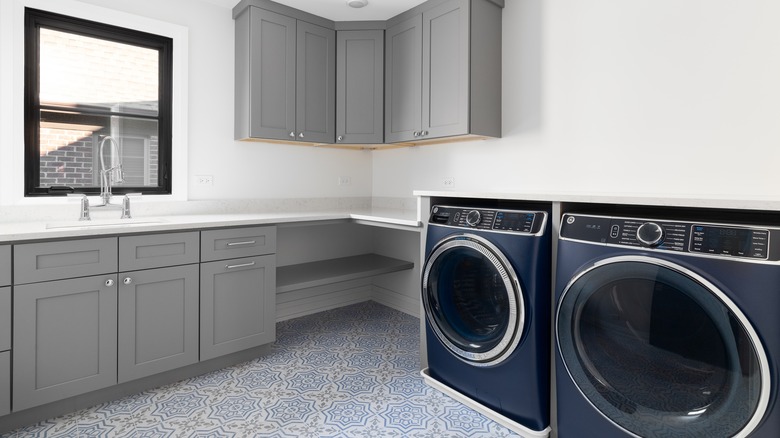Why Wood Floors Don't Belong In Your Laundry Room
Stepping onto a wood floor evokes a sense of warmth and natural elegance that few other materials (if any) can match. The myriad of shades from the dark hue of walnut to the bright tone of maple are a toast to our individual tastes. Further, the allure of hardwood floors is not just superficial. According to Realtor.com, investing in wood flooring can pay off big time and could even increase your home's resale value by 2.5%. However, amidst this chorus of accolades, wood doesn't hold its ground in the high-stakes environment of your laundry room. Here, water (damp clothes, humidity, and spills from your washing machine) is not a mere visitor but a constant inhabitant. And, as you probably know, water is wood flooring's Achilles' heel, with continued exposure leading it to warp, stain, and grow mold.
The fragile relationship between wood floors and moisture reveals a critical mismatch that questions the wisdom of using the flooring option in a laundry room. It's also the very reason you want to avoid wood flooring in your bathroom. However, this isn't to say you must sacrifice style for functionality. A line-up of flooring materials is available that offer the visual appeal of hardwood, complemented by the resilience needed to withstand the rigors of laundry room life. Now, the script shifts from restricting your choice to rolling out a carpet of options that will make your laundry room as inviting as the rest of your home without sweating over potential water damage.
Water sets up wood flooring for serious damage
In your laundry room, a silent battle is waged between wood floors and moisture. Wood, a naturally-hygroscopic material, absorbs moisture from the air like a sponge, its porous structure an open invitation for water to seep in and make itself at home. The enemy isn't always a rogue spill, leaking pipe, or washing machine but also the very air in your laundry room that's thick with humidity from washing and drying cycles. The unchecked onslaught from moisture causes wood planks to expand and contract, triggering a chain reaction of warping and buckling that compromises their structural integrity and visual charm. Not to mention that the cost of repairing water-damaged wood floors can escalate quickly, ranging widely from $8 to a staggering $100 per square foot.
However, the water-inflicted scars on wood flooring can take other forms besides just swollen planks. Enter stains. These blemishes range from faint stains, indicative of condensation-triggered skirmishes, to dark stains, heralding significant damage beneath. And just when you thought it couldn't get worse, a more sinister threat finds its footing — mold, which thrives in warm, humid environments. It sets roots beneath the wood flooring, out of sight but not out of consequence. Mold heralds not just the loss of the wood's pristine condition through discoloration and the introduction of musty or tangy odors, as its spores elevate the stakes to allergic reactions in asthmatic and other vulnerable individuals (per the U.S. Environmental Protection Agency).
Best alternatives to wood for laundry room flooring
Ceramic or porcelain tile, boasting a resilience that withstands the beatings of laundry day, emerges as a frontrunner for the best flooring for laundry rooms. These flooring chameleons are aesthetically-appealing thanks to their diverse colors and patterns (including those that mirror wood flooring without its moisture-averse temperament). They are tough cookies too, ready to stand up against water or chemical assaults and bear the brunt of dropped items and heavy traffic. Ease of maintenance is the cherry on top. For those moments when tiles feel cold underfoot, just toss down a cozy mat or rug.
Longing for something beyond the ceramic coolness that's more comfortable underfoot without the worries of water damage in wood? Enter vinyl flooring. With a spectrum of styles that mimic stone, hardwoods, or sleek ceramic at a fraction of the cost, this smooth operator offers a water-resistant haven that's more soundproof, too. Its deluxe cousin, luxury vinyl tiles, elevate the experience with enhanced rigidity, along with superior comfort and sound dampening.
Finally, concrete flooring, with its unyielding surface and industrial aesthetic, offers a no-nonsense option for those who favor practicality above all. Its robust nature mockingly-scoffs at moisture and stains, so it's an excellent choice for areas grappling with high humidity and spills. Yet, the perceived blandness of concrete is but a canvas awaiting transformation. With paint or other touches (think polish), you can infuse the concrete floor in your laundry room with warmth and character.


